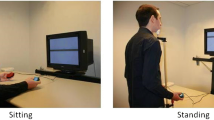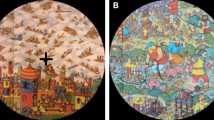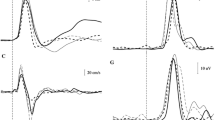Abstract
Three experiments examined interactions between posture control in upright stance and a concurrent location memory task. Healthy young participants stood upright and memorized the locations of dots presented on a computer screen. In the retrieval phase, they indicated whether arrows presented on the screen would pass through any of the memorized locations. Postural sway variability was measured either during the retention period or during retrieval. Relative to not performing the memory task, postural sway variability increased in the retention period when the eyes were closed, but remained unaffected when the eyes were open. During retrieval, postural sway variability was reduced relative to the no-memory-task condition. Results were interpreted in terms of dual-task costs associated with maintaining multiple frames of reference.




Similar content being viewed by others
Notes
More generally, the spatial cognition literature suggests that enduring representations of locations of environmental objects use intrinsic (i.e., allocentric) reference frames (Rump and McNamara 2007). Neggers et al. (2006) suggest that this may be because egocentric encoding is essentially a parietal cortical process invoked in the context of goal-directed action, whereas allocentric coding is used by the ventral visual processing stream in the context of location judgment tasks (such as the one used in the present study).
References
Andersson G, Yardley L, Luxon L (1998) A dual-task study of interference between mental activity and control of balance. Am J Otol 19:632–637
Balasubramaniam R, Riley MA, Turvey MT (2000) Specificity of postural sway to the demands of a precision task. Gait Posture 11:12–24
Barra J, Bray A, Sahni V, Golding JF, Gresty MA (2006) Increasing cognitive load with increasing balance challenge: recipe for catastrophe. Exp Brain Res 174:734–745
Brown LA, Sleik RJ, Polych MA, Gage WH (2002) Is the prioritization of postural control altered in conditions of postural threat in younger and older adults? J Gerontol A-Biol 57A(12):M785–M792
Deviterne D, Gauchard GC, Jamet M, Vancon G, Perrin PP (2005) Added cognitive load through rotary auditory stimulation can improve the quality of postural control in the elderly. Brain Res Bull 64:487–492
Fraizer EV, Mitra S (2008a) Methodological and interpretive issues in posture-cognition dual-tasking in upright stance. Gait Posture 27:271–279
Fraizer EV, Mitra S (2008b) Postural costs of performing cognitive tasks in noncoincident reference frames. Exp Brain Res 185:429–441
Kunde W, Hoffmann J (2005) Selecting spatial frames of reference for visual target localization. Exp Psych 52:201–212
Li KZH, Lindenberger U (2002) Relations between aging sensory/sensorimotor and cognitive functions. Neurosci Biobehav R 26:777–783
Maylor EA, Wing AM (1996) Age differences in postural stability are increased by additional cognitive demands. J Gerontol B- Psychol 51B(3):P143–P154
McNevin NH, Wulf G (2002) Attentional focus on supra-postural tasks affects posture control. Hum Mov Sci 21:187–202
Melzer I, Benjuya N, Kaplanski J (2001) Age-related changes of postural control: effect of cognitive tasks. Gerontol 47:189–194
Mitra S (2003) Postural costs of suprapostural task load. Hum Mov Sci 22:253–270
Mitra S, Fraizer EV (2004) Effects of explicit sway minimization on postural-suprapostural dual-task performance. Hum Mov Sci 23:1–20
Neggers SFW, Van der Lubbe RHJ, Ramsay NF, Postma A (2006) Interactions between ego- and allocentric neuronal representations of space. NeuroImage 31:320–331
Paulus W, Straube A, Krafszyk S, Brandt T (1989) Differential effects of retinal target displacement, changing size and changing disparity in the control of anterior/posterior and lateral body sway. Exp Brain Res 78:243–252
Pellecchia GL (2003) Postural sway increases with attentional demands of concurrent cognitive task. Gait Posture 18:29–34
Ramenzoni VC, Riley MA, Shockley K, Chiu C-YP (2007) Postural responses to specific types of working memory tasks. Gait Posture 25:368–373
Riley MA, Turvey MT (2002) Variability and determinism in motor behavior. J Mot Behav 34:99–125
Riley MA, Stoffregen TA, Grocki MJ, Turvey MT (1999) Postural stabilization of the control of touching. Hum Mov Sci 18:795–817
Roberts TDM (1995) Understanding balance: the mechanics of posture and locomotion. Chapman & Hall, London
Rump B, McNamara T (2007) Updating models of spatial memory. In: Barkowski T, Knauff M, Ligozat G, Montello DR (eds) Spatial cognition V: lecture notes in artificial intelligence. Springer, Berlin, pp 249–269
Smart LJ, Mobley BS, Otten EW, Smith DL, Amin MR (2004) Not just standing there: the use of postural coordination to aid visual tasks. Hum Mov Sci 22:769–780
Stoffregen TA, Smart LJ, Bardy BG, Pagulayan RJ (1999) Postural stabilization of looking. J Exper Psychol: Hum Percep Perform 25:1641–1658
Stoffregen TA, Pagulayan RJ, Bardy BG, Hettinger LJ (2000) Modulating postural control to facilitate visual performance. Hum Mov Sci 19:203–220
Stoffregen TA, Bardy BG, Bonnet CT, Pagulayan RJ (2006) Postural stabilization of visually guided eye movements. Ecol Psychol 18:191–222
Stoffregen TA, Hove P, Bardy BG, Riley M, Bonnet CT (2007) Postural stabilization of perceptual but not cognitive performance. J Mot Behav 39:126–138
Swan L, Otani H, Loubert PV, Sheffert SM, Dunbar GL (2004) Improving balance by performing a secondary cognitive task. Br J Psychol 95:31–40
Vander Velde TJ, Woollacott MH, Shumway-Cook A (2005) Selective utilization of spatial working memory resources during stance posture. NeuroReport 16:773–777
Weeks DL, Forget R, Mouchnino L, Gravel D, Bourbonnais D (2003) Interaction between attention demanding motor and cognitive tasks and static postural stability. Gerontology 49:225–232
Woollacott M, Shumway-Cook A (2002) Attention and the control of posture and gait: a review of an emerging area of research. Gait Posture 16:1–14
Wulf G, Mercer J, McNevin N, Guadagnoll MA (2004) Reciprocal influences of attentional focus on postural and suprapostural task performance. J Mot Behav 36:189–199
Acknowledgments
Michael Riley, Nichole Saunders, Adam Kiefer, and Sebastian Wallot were supported by NSF (USA) grants HSD 0728743, BCS 092662, BCS 0642716, and BCS 0843133. Suvobrata Mitra was supported by ESRC (UK) grants RES-000-22-2248 and RES-000-22-4433.
Author information
Authors and Affiliations
Corresponding author
Rights and permissions
About this article
Cite this article
Riley, M.A., Mitra, S., Saunders, N. et al. The interplay between posture control and memory for spatial locations. Exp Brain Res 217, 43–52 (2012). https://doi.org/10.1007/s00221-011-2970-y
Received:
Accepted:
Published:
Issue Date:
DOI: https://doi.org/10.1007/s00221-011-2970-y




